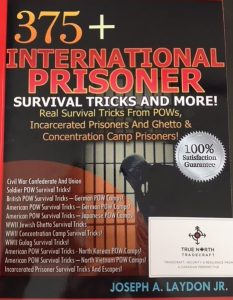A while ago I heard about a book which chronicled the history and evolution of skills and tips for the Prisoners of War (POWs) or captives in a foreign land. After much digging, I contacted the author, Mr. Joseph A. Laydon Jr., and arranged to purchase a copy to be shipped to Canada.
Mr. Laydon was very kind and forthcoming in his communications with me and I received my copy (and a bunch of other goodies) from him shortly afterward.
Mr. Laydon’s compendium is a ~350-page tome of well researched historical material. He has dug deep into the world of POWs (in an American context, specifically) from the US Civil War to Cold War-era and their methods of survival, escape and reunification through simple tips as well as in-depth case studies.

As the nature of warfare has changed with the introduction of ever-advancing technologies, the realities of captivity remain. Allied soldiers have been held captive in more recent conflicts such as the Gulf Wars, The Balkans/Former Yugoslavia and in the Middle East. And though one never knows in advance the circumstances of one’s possible captivity, a study of historical methods (both by captors and captives) is beneficial. It gives scope and depth of knowledge which may be adapted in given circumstances. In some current theatres of conflict, one’s adversaries may tend to be on the less-technologically advanced side. If one is to be effective in combating such foes, a study into their “low-tech” methods will yield insight into their weaknesses. To that end, studying past historical methods of captivity and restraint allows for the operator or agent to understand the weaknesses in those methods and train to exploit those weaknesses to one’s advantage.

As an example, “high tech” security features, such as locks and handcuffs, may be in use by one’s own forces, but in some areas in the world, technology may be 50-80 years behind the times, often using outdated and “low tech” restraints and locking mechanisms. Awareness and training in the exploitation of these are crucial to one’s survival.

I would also argue that even by reading through it in a non-military or operational context, if one were to find themselves kidnapped or held in unlawful confinement, some of the points discussed in this book may be of help, again depending on the circumstances. But the more you know, the more options you may have.
To bring this around full circle, Mr. Laydon does an excellent job of providing a thoroughly researched historical account of survival methods used by POWs and also the captivity methods of their captors and aggressors over a very long period of time across a wide range of theatres. Even more useful are his personal notes from his time in the Military and through various survival schools. All very useful information. There are many practical and informative (and genuinely interesting) tips and tricks covered. It is not an instructional manual, per se, but rather an in-depth reference highlighting many historical and contemporary methods and ideas for use in such environments. The author has augmented historical methods with personal anecdotes and experiences to bring context. There are no pictures or diagrams to see (though there are a few exercises to learn some of the tricks shown) however the sheer multitude of referenced tips and tricks leaves one much to internalize and think about. I would recommend this publication to anyone looking to expand their knowledge of this subject matter. Sometimes, the saying “what’s old is new again” may come to pass. You never know, it may come in handy some day.
Though the information in this book is good to know, Would highly recommend finding training in these skillsets in-person. Nothing beats hands-on instruction and personal first-hand experience.
Joseph A. Laydon Jr. can be reached through www.survivalexpertbooks.com or at [email protected] and this book can be found on Amazon.com and Amazon.ca . He has written many other books on various other survival-related topics, similarly sized and deeply researched.
Till next time, stay safe and Stay Crafty.


